#lucio fulci crime
Explore tagged Tumblr posts
Text
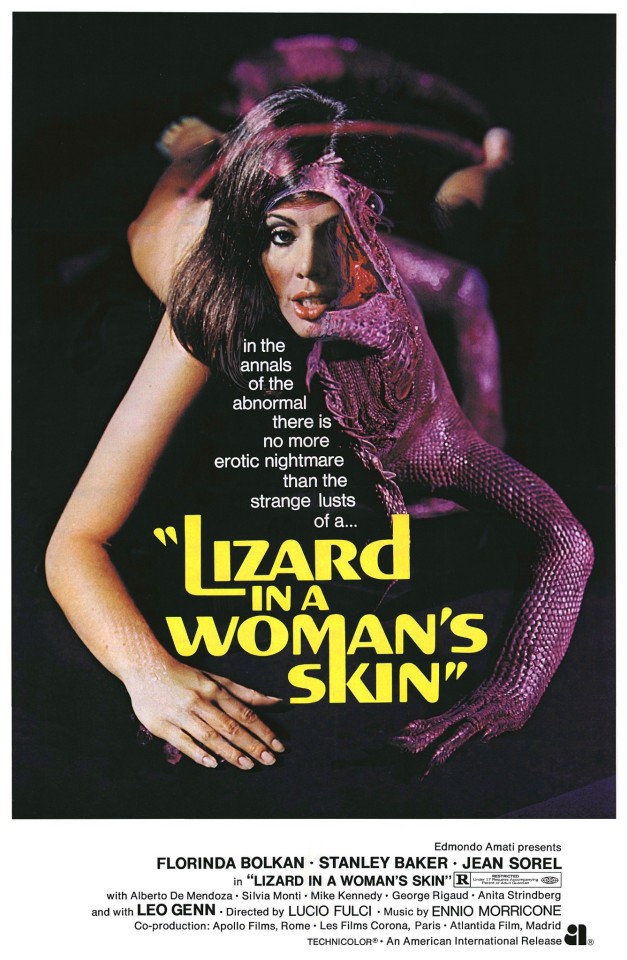
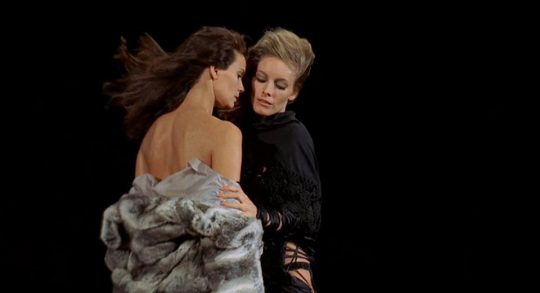

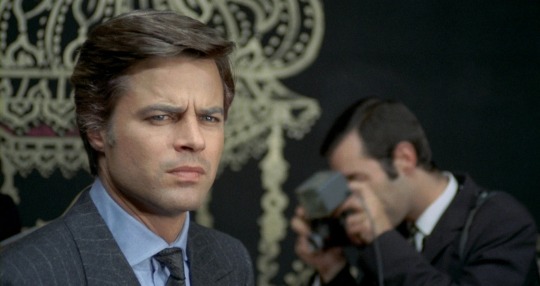


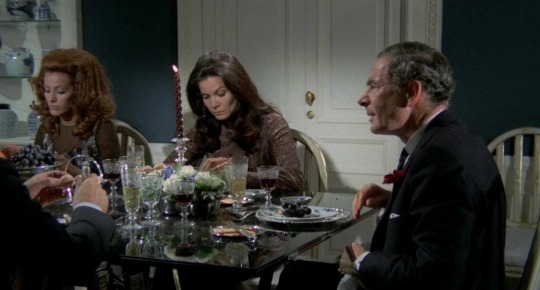
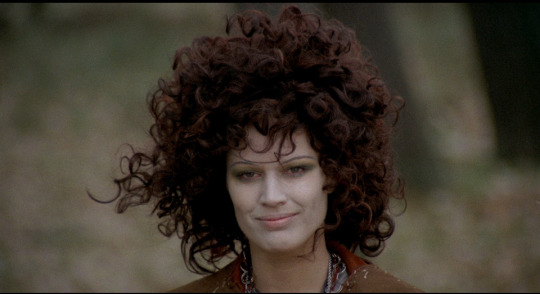
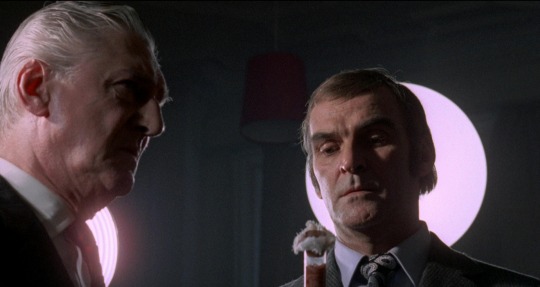
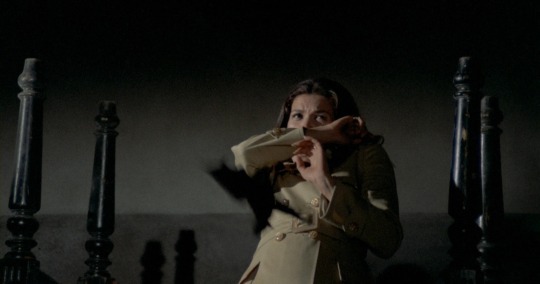
Una lucertola con la pelle di donna (A Lizard in a Woman's Skin, 1971)
"You dream of having an affair with this woman who lives next door. To you, that woman represents sin, moral degradation. The house next door is a symbol of vice. From what you've told me, Mrs. Durer is not exactly respectable."
"No... she certainly is not."
#una lucertola con la pelle di donna#a lizard in a woman's skin#lucio fulci#italian cinema#1971#roberto gianviti#josé luis martínez mollá#florinda bolkan#stanley baker#jean sorel#silvia monti#alberto de mendoza#penny brown#mike kennedy#ely galleani#george rigaud#leo genn#anita strindberg#basil dignam#ennio morricone#mesmerising. ymmv of course‚ and this does seem to be fairly divisive; I've read reviews by people who hated this or (even stranger to me)#found it to be poorly made. well not so‚ say i. Fulci in unusually restrained form‚ still stylish as all hell‚ but not allowing the visual#flourishes and artful winks at the audience to drown out the narrative. the plot itself is a twisty turny thing and almost in danger of#getting too involved in itself‚ but it all pulls together by the close. hard to see in the uk for many years because of a scene of animal#cruelty which ironically‚ for once in an Italian film‚ wasn't real but fx work; albeit fx work so convincing that it actually led to a cour#case and fx maestro Carlo Rambaldi having to demonstrate the effect in front of a jury to prevent Fulci potentially receiving a prison#sentence (or so the story goes). a longer waffling review is on my letterboxd but suffice to say that‚ for me personally‚ this was a hugely#satisfying watch after many years of anticipation. Bolkan is fascinating‚ mercurial; Strindberg (strangely uncredited) is understood only#from the pov of other characters; Baker is a wonderfully cold‚ dispassionate investigator of terrible crimes. and it all looks beautiful#plus it's one of a very few gialli set in the uk to actually bother going there to film! which means unexpected brit character actors!
15 notes
·
View notes
Text








CONTRABAND
Italy
1980
Directed by Lucio Fulci
7 notes
·
View notes
Text
The New York Ripper (1982): A Harrowing Dive into Psychological Horror
The New York Ripper (1982)
Synopsis- A burned-out New York police detective teams up with a college psychoanalyst to track down a vicious serial killer randomly stalking and killing various young women around the city. Director – Lucio Fulci Cast – Jack Hedley, Paolo Malco, Howard Ross Genre- Horror | Crime Released – 1982 ⭐⭐⭐⭐⭐ Rating: 4.5 out of 5. Lucio Fulci’s “The New York Ripper” stands as a controversial,…
#1980s Cinema#★★★★#cinema#Crime#Featured#film review#Film Reviews#Horror#Howard Ross#Jack Hedley#Lucio Fulci#movie review#Paolo Malco#slasher
0 notes
Note
2, 3 , 14, 15, 21, 22, 26 for film asks :3
2 A movie you think is underrated
Intruder, The Stepfather 1987, Mirror Mirror, The Faculty, Office Space, Opera, Bloodletting 1997, Trick or Treat 1986 , Empire Records, Psycho Beach Party
3 A movie you think is overrated
Twelve Monkeys had some terrible hospital scenes, I find many rom coms creepy and disturbing (Sleepless in Seattle)
14 A movie made better by the ending
First Terminator ending sequence with fire and hydraulic press is really satisfying
15 A movie ruined by the ending
I love The Breakfast Club, but this "glow up" is a crime. Also Maxxxine, I am a huge fan of this trilogy, but the ending was mid
21 A director you think is underrated
Lucio Fulci
22 A director you think is overrated
Tobe Hooper (?)
26 Your least favourite movie
Blood Lake
3 notes
·
View notes
Text
“New-To-Me” - May 2023
What Really Happened to Baby Jane (1963, Ray Harrison)
All About Alice (1972, Ray Harrison)
Single White Female (1992, Barbet Schroeder)
The Salt Mines [1990] & The Transformation [1996] (Susana Aikin & Carlos Aparicio)
The Key to Reserva (2007, Martin Scorsese)
Crimes of Passion (1984, Ken Russell)
The Backrooms (Found Footage) (2022, Kane Parsons)
Witness for the Prosecution (1957, Billy Wilder)
The Fluffer (2001, Richard Glatzer & Wash Westmoreland)
+++
Always on Sunday (1962, Ray Harrison)
Am I Alive or Am I Dead? (2002, Katya Zamolodchikova)
Dracula: Dead and Loving It (1995, Mel Brooks)
Fleshtone (1994, Harry Hurwitz)
Jade (1995, William Friedkin)
My Cousin Vinny (1992, Jonathan Lynn)
Operation Avalanche (2016, Matt Johnson)
The Roman Springs on Mrs. Stone (1963, Ray Harrison)
Something Wild (1986, Jonathan Demme)
Spy on the Fly (1967, Ray Harrison)
Zombie Flesh Eaters (1979, Lucio Fulci)
New Releases:
Are You There God? It’s Me, Margaret. (Kelly Fremon Craig)
Evil Dead Rise (Lee Cronin)
Reality (Tina Satter)
Saint Omer (Alice Diop)*
Sanctuary (Zachary Wigon)
5 notes
·
View notes
Text
Some of my personal all time favourite films:
Man Of The West (1958, Anthony Mann)
Scarlet Street (1945, Fritz Lang)
Ran (1985, Akira Kurosawa)
The Strawberry Blonde (1941, Raoul Walsh)
Strangers On A Train (1951, Alfred Hitchcock)
The Evil Dead (1981, Sam Riami)
The Mask Of Zorro (1998, Martin Campbell)
Love & Basketball (2000, Gina Prince-Bythewood)
The Gunfighter (1950, Henry King)
Straw Dogs (1971, Sam Peckinpah)
The People Under The Stairs (1991, Wes Craven)
Candyman (1992, Bernard Rose)
Deathdream (1974, Bob Clark)
The Babadook (2014, Jennifer Kent)
Christine (1983, John Carpenter)
Day Of The Dead (1985, George Romero)
The Prestige (2006, Christopher Nolan)
The Stepfather (1987, Joseph Ruben)
Nightcrawler (2013, Dan Gilroy)
Whiplash (2014, Damien Chazelle)
Halloween II (2009, Rob Zombie)
Hulk (2003, Ang Lee)
Logan (2017, James Mangold)
Birds Of Prey & The Fantabolous Emancipation Of One Harley Quinn (2020, Cathy Yan)
Professor Marston & The Wonder Women (2017, Angela Robinson)
Dawn Of The Planet Of The Apes (2014, Matt Reeves)
Batman Returns (1992, Tim Burton)
Don't Torture A Duckling (1972, Lucio Fulci)
Ben-Hur (1959, William Wyler)
Barry Lyndon (1975, Stanley Kubrick)
The Mummy (1999, Stephen Sommers)
Being John Malkovich (1999, Spike Jonze)
Cult Of Chucky (2017, Don Mancini)
Bigger Than Life (1956, Nicholas Ray)
The Man Who Shot Liberty Valance (1962, John Ford)
The Invisible Man (2020, Leigh Whannell)
Mildred Pierce (1945, Michael Curtiz)
All The Real Girls (2003, David Gordon Green)
The Phenix City Story (1955, Phil Karlson)
Crime Wave (1954, Andre De Toth)
Ride Lonesome (1959, Budd Boetticher)
Baby Boy (2001, John Singleton)
Bamboozled (2000, Spike Lee)
Witchfinder General (1968, Michael Reeves)
Frankenstein Must Be Destroyed (1969, Terence Fisher)
Toy Story 2 (1999, John Lassiter, Lee Unkrich)
Dead Ringers (1988, David Cronenberg)
Pearl (2023, Ti West)
Dr Jekyll & Mr Hyde (1931, Reuben Moumalian)
Frailty (2001, Bill Paxton)
Megamind (2010, Tom McGrath)
3:10 To Yuma (1957, Delmer Daves)
Event Horizon (1997, Paul W.S. Anderson)
Breakdown (1997, Jonathan Mostow)
Starship Troopers (1997, Paul Verhoeven)
Sugar (2008, Anna Boden & Ryan Fleck)
Outland (1981, Peter Hyams)
Tarzan's Greatest Adventure (1959, John Guillerman)
Possessor (2020, Brandon Cronenberg)
Freaky (2020, Christopher Landon)
First Blood (1982, Ted Ketchoff)
A Perfect World (1993, Clint Eastwood)
1 note
·
View note
Text

#HARPERSMOVIECOLLECTION
2023
https://www.tumblr.com/theharpermovieblog?source=share
I watched Don't Torture A Duckling (1972)
A Giallo horror from the master of gore, Lucio Fulci.
A rural town experiences a series of child murders.
Director Lucio Fulci is best known for his Zombie films and Mystical gore-fests. If you don't know who he is, look up the Fulci Zombie and you might recognize the image.
This film is an earlier work of Fulci's. Rather than any magic or monsters, Don't Torture A Duckling is a Giallo murder mystery film with a human killer on the loose.
Despite the overdub in both the Italian and English versions, something I don't love outside of B-Horror, this movie still manages to pull off a sense of tension, mystery and horror.
Fulci's shots are often well chosen and at one point he gives us a shot of the town that feels ominous before the sting of music even begins.
The actors are capable of working past the dub. In fact, if you shut the sound off, the film might be even more effective.
The special effects aren't always perfect, but they work well enough, despite one of them making me laugh.
The reactions from the townsfolk, which we either see or hear about, give a sense of reality to the town as a whole, and to the disruption and fear brought on by the heinous crime of killing children.
This film isn't exactly the most original, but it's engaging due to a well written script and Lucio Fulci's abilities behind the camera. Wherever it falls short is more minor than many other Giallo films. I'd take this over an Argento Giallo for sure.
Fulci's later movies aren't as intricately written, and those films seem to focus much more on the gore and shock value. Which is fun and I love a lot of Fulci's later work, but when looking for a good story, this film is where he shines.
It's a mystery and it largely plays out like a procedural thriller. Cops doing leg work, a reporter asking all the right questions and suspects popping up throughout. But, it's also the story of several different characters throughout the town.
I particularly loved the scene where cops with dogs are chasing a female suspect through the woods. It was chaotic and very well done. A scene which could be replicated today without changing a shot or edit.
In fact, that particular woman's entire story in the film is all very well done and is probably my favorite part of any Giallo film I've seen.
Ahead of it's time.
Overall, I enjoyed this one a lot more than I expected to. I'm not a huge Giallo film fan, but if I were to choose a favorite, this would be in the running.
1 note
·
View note
Text

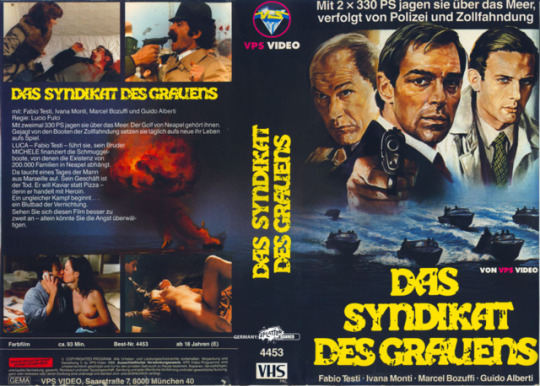


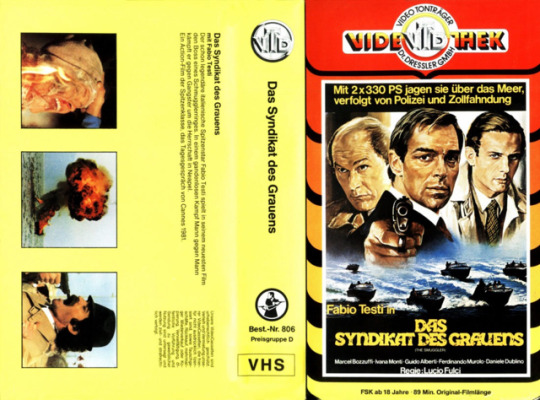
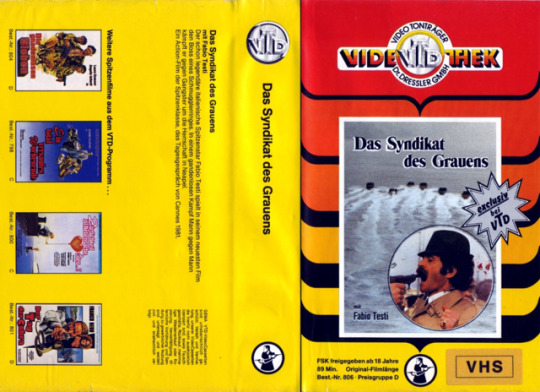
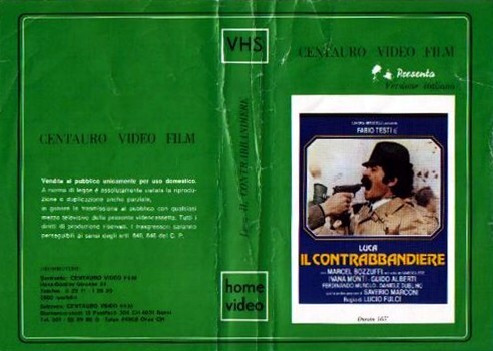
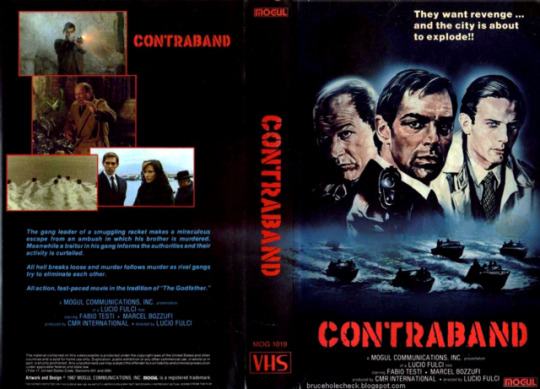

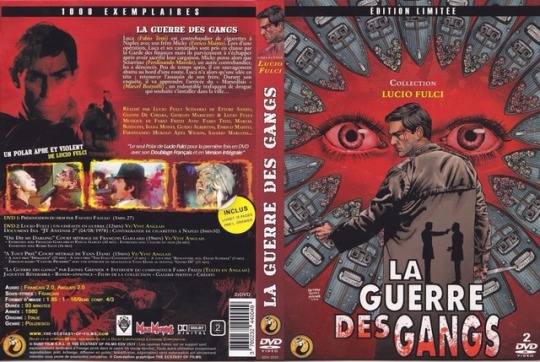
(some Rare VHS 📼 Cover...& Dvd)
1980
Luca il contrabbandiere
Also Known As (AKA)
(original title) Luca il contrabbandiere
Belgium (French title) (video title) Lucas le contrebandier
Brazil Luca o Contrabandista
Canada (French title) Lucas le vengeur
Denmark (DVD title) Napoli forbindelsen
France La Guerre des Gangs
Greece (video title) O lathremporos
Netherlands (informal literal title/video box title) The Smuggler
Norway Brennpunkt Napoli
Portugal O Contrabandista
Soviet Union (Russian title) Контрабанда
Spain Luca el contrabandista
UK (video title) The Naples Connection
UK (video title) The Smuggler
USA contraband 1980
West Germany Das Syndikat des Grauens
World-wide (English title) The Smuggler
(literal English title) Luca the Smuggler
Release Dates
Italy 8 August 1980
Spain 5 April 1981
West Germany 7 May 1982
USA 23 July 1982 (limited)
Portugal 27 May 1983
Mexico 21 May 1984
Finland 2007 (DVD premiere)
UK 19 May 2014
Directed by Lucio Fulci
Music by Fabio Frizzi
Writing Credits
Ettore Sanzò ... (story/screenplay)
Gianni De Chiara ... (story/screenplay)
Lucio Fulci ... (screenplay)
Giorgio Mariuzzo ... (screenplay)
Filming Dates
3 December 1979 - March 1980
Filming Locations
Naples, Campania, Italy
technical specifications
Runtime 1 hr 37 min (97 min)
1 hr 28 min (88 min) (25 fps) (cut) (UK)
Cast
Fabio Testi ... Luca Di Angelo
Ivana Monti... Adele Di Angelo
Marcel Bozzuffi ... The Marsigliese - Francois Jacois
Lucio fulci ... Old Boss (uncredited)
Giulio Farnese ... Alfredo
Venantino Venantini ... Captain Tarantino
Ajita Wilson ... Luisa
Luciano Rossi ... Chemist
Salvatore Billa ... Marsigliese Thug
Romano Puppo ... Enforcer
Omero Capanna ... Marsigliese Thug
Saverio Marconi ... Luigi Perlante
Enrico Maisto ... Mickey Di Angelo
Ferdinando Murolo ... Scherino
Fabrizio Jovine ... Chief of Police
Daniele Dublino ... Prosecutor
Guido Alberti ... Don Morrone
Giordano Falzoni ... Charlie
Ofelia Meyer ... Ingrid
Tommaso Palladino ... Capece
Virgilio Daddi ... Marsigliese Thug
Cintia Lodetti ... Ursula
Rita Frei ... Filomenia
Nello Pazzafini ... Traitor (as Giovanni Pazzafini)
#luca il contrabbandiere#contraband#the contraband#the smuggler#lucio fulci#luciofulci#lucio fulci crime#poliziotteschi#poliziottesco#venantino venantini#venantinovenantini#luciano rossi#giallo fever#giallofever#italian cult#italian giallo#gialli#cult#cinema cult#italian sexy comedy#international cult#giallo
6 notes
·
View notes
Text



5 notes
·
View notes
Text










Murder to the Tune of the Seven Black Notes
#film still#film#movie#movie recommendation#film recommendation#art cinema#horror#murder#crime#thriller#lucio fulci#sette note in nero#tarantino#quentin tarantino#kill bill#movie reference#film caps
4 notes
·
View notes
Text








Lizard In A Woman's Skin (dir. Lucio Fulci)
#lizard in a woman's skin#una lucertola con la pelle di donna#lucio fulci#florinda bolkan#jean sorel#silvia monti#stanley baker#giallo#horror#crime#murder#psychological thriller#thriller#mistery#my gifs#moviegifs
28 notes
·
View notes
Text










CONTRABAND
Italy
1980
Directed by Lucio Fulci
20 notes
·
View notes
Text
Movie Review | Knife of Ice (Lenzi, 1972)

This review contains spoilers about the ending in the last paragraph, so maybe don’t read that part if you haven’t seen the movie yet.
A few years ago I watched a documentary about giallo whose name escapes me, and one of the few things I remember from it clearly is Umberto Lenzi griping about how Dario Argento got all the credit for inventing giallo when Lenzi’s entries in the genre preceded him. I wasn’t gonna challenge Lenzi’s claim about the historical record, but still found it amusing that he was taking shots at Argento, given that from my experience, his body of work was nowhere near as strong as Argento’s. Granted, at the time I’d only seen Nightmare City (fun, but dumb as hell) and his cannibal movies (varying degrees of terrible), and since then I’ve seen at least two poliziotteschi movies from him (The Tough Ones and Almost Human) that suggest he could actually make genuinely exciting movies. (Interestingly, the looseness and arguably slapdash construction that I found so off-putting in his cannibal movies is actually a boon in his crime films, rendering them almost free-associative exercises in cop-vs-crook brutality.) So finally I decided to watch one of his giallos, and while I still don’t think he’s in a position to be taking shots at Argento, I did enjoy the movie.
To an extent, it’s tough for me to meaningfully review giallos. They are almost by definition is stylish and sexy, so the fact that a movie falls in the genre means that I’m going to get a bit of enjoyment out of it. This one is definitely stylish, thanks to the handsome widescreen cinematography and the Spanish locations that situate the movie somewhere between rustic and decadent. And it’s not just nice to look at, but atmospheric too, like a nighttime scene where a character runs down a starkly lit street. It’s maybe a little less sexy, in that there isn’t any onscreen funny business. In fact, it’s a pretty tame movie in other ways, in that there isn’t much onscreen violence either, aside from gruesome bullfight footage that the movie keeps pulling out. I would be in the right to knock it for that reason, but quite frankly I like spending time in the worlds of giallo enough that I didn’t mind that we weren’t getting too many jolts, it was nice enough to traipse through these cobblestone streets, drive down the beautiful countryside and relax in these cozy looking villas. From a genre identity standpoint, you can actually see some pretty pronounced strains of influence. A scene in a cemetery where a character runs in a cape foregrounds the kind of decadence inherited from gothic horror, while the appearance of the heroine played by Carroll Baker very much brings to mind Hitchcock’s blondes. There’s a neat sequence late in the movie where the characters reenact their actions prior to a murder that would very much feel at home in a Hitchcock movie.
As I mentioned earlier, Carroll Baker plays the heroine, a mute woman who finds herself in the middle of a bunch of murders that the police speculate are by either a sex maniac or a satanist. (I assume when you look at the encyclopedia or criminal profiles under the letter S, these are the first two categories.) Italy at the time was where fading Hollywood stars would go to continue getting lead roles, and this is something that works in favour of Baker’s performance here, giving her a slight shade of disreputability, as if she might have something to hide. I’ve expressed before a slight discomfort around how movies might exploit a character’s disability, and that’s definitely something to chew over here. The lack of dialogue leaves Baker to be more overtly expressive, and you can feel the camera probing her face for microexpressions when it goes in for its eye closeups. (That’s not the only similarity with Lucio Fulci’s movies here; we also get a Donald Duck toy.) I do think Baker manages to imbue her character with a certain dignity, meaning that the movie is pretty palatable in this respect for the majority of the runtime.
Of course, if you watch this on Tubi, the description alludes to an insane twist ending. I must report that this twist undoes whatever points the movie had accumulated in its handling of the heroine’s disability, as it turns out Baker killed her singer friend out of jealousy and then regains her voice right at the end. It’s so audaciously offensive that I can’t help but be a little impressed.
2 notes
·
View notes
Text
Ophelia By the Yard
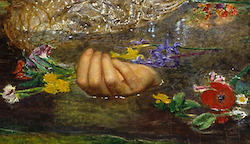
Cobwebbed passages and wax-encrusted candelabra, dungeons festooned with wrist manacles, an iron maiden in every niche, carpets of dry ice fog, dead twig forests, painted hilltop castles, secret doorways through fireplaces or behind beds (both portals of hot passion), crypts, gloomy servants, cracking thunder and flashes of lightning, inexplicably tinted light sources, candles impossibly casting their own shadows, rubber bats on wires, grand staircases, long dining tables, huge doors with prodigiously pendulous knockers to rival anything in Hollywood.
Here was the precise moment — and it was nothing if not inevitable — when the darkness of horror film, both visible and inherent, leapt from the gothic toy box now joined by a no less disconcerting array of color. The best, brightest, sweetest, and most dazzling red-blooded palette that journeyman Italian cinematographers could coax from those tired cameras. Color, both its commercial necessity as well as all it promised the eye, would hereafter re-imagine the genre’s possibilities, in Italy and, gradually, everywhere else.
When color hit the Italian Gothic cycle, a truly new vision was born. In Hammer films and other UK horror productions, the cheapness of Eastmancolor made it possible for blood to be red. Indeed, very red. And, while we shouldn't underestimate the startling impact this had, it was a fairly literal use of the medium. In the Italian movies, and to a large extent in Roger Corman's Poe cycle, color was an unlikely vehicle to further dismantle realism rather than to assert it. Overrun with tinted lights and filters, none of which added to the film’s realistic qualities, the movies became delirious. In Corman's Masque of the Red Death, we learn of an experiment that uses color to drive a man insane; it seems that filmmakers like Corman and Mario Bava were attempting the very same trick on their audiences.
The application of candy-wrapper hues to a haunted castle flick like The Whip and the Body adds a pop art vibe at odds with the genre, and when you get to something like Kill, Baby...Kill! the Gothic trappings are barely able to mask a distinctly modern sensibility, so much so that Fellini could plunder its phantasmal elements for Toby Dammit, fitting them perfectly into his sixties Roman nightmare.
Blood and Black Lace brings the saturated lighting and Gothic fillips into the twentieth century -- a sign creaking in a gale is the first image, translated from Frankensteinland to the exterior of a contemporary fashion house. A literal faceless killer disposes of six women in diabolical ways. The sour-faced detective remains several deaths back on the killer’s trail because the movie knows its audience, knows that it has zero interest in detection, character, motivation — though it’s all inertly there as a pretext for sadism, set-pieces of partially-clad women being hacked up, dot the film like musical numbers or action sequences might appear in a different genre.
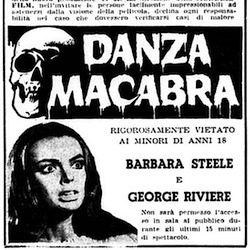
Since the 19th-century audience for literary Gothic Horror was comprised of far fewer men than women, would it be fair to ask whether Giallo’s advent might be an instrument of brutal violence, even revenge against “feminine” preoccupations? Consider 1964’s Danza Macabra, the film’s amorous vibes finding their ultimate source in that deathless screen goddess named Barbara Steele, whose marble white flesh photographs like some monument to classicism startled into unwanted Keatsian fever. Her presence practically demands that we ask ourselves: “Who is this wraith howling at a paper moon?” In other words, is it a coincidence that Steele’s “Elizabeth Blackwood” — a revenant temptress and undead sex symbol — hits screens the very same year as Giallo, which would transform Italian cinema into a decades-long death mill for women?
The name “giallo”, meaning yellow, derives from the crime paperbacks issued by Italian publisher Mondadori. The eye-catching covers, featuring a circular illustration of some act of infamy embedded in a yellow panel, became utterly associated with the genre of literature. These books were likely to be by Edgar Wallace, the most popular author in the western world, or Agatha Christie: cardboard characters sliding through the most mechanical of plots; or classier local equivalents, like Francesco Mastriani or Carolina Invernizio. The founding principles laid down concerned the elaborate deceptions concealed by their authors, traps for the unwary reader, and the use of a distinctive design motif. The tendency of the characterisation to lapse into sub-comic-book cliché, the figures incapable of expressing or inspiring real sympathy, was, perhaps, an unintended side-effect of the focus on narrative sleight-of-hand.
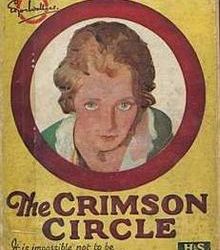
When Italian filmmakers sought to translate sensational literature to the screen, they looked to other filmic influences: American film noir, influenced by German expressionism and often made by German emigrés (Lang, Siodmak, Dieterle, Ulmer); and the popular krimi cycle being produced in West Germany, mostly based on Edgar Wallace's leaden "shockers." These deployed stock characters, bizarre methods of murder, deceptive plotting, and exuberant use of chiaroscuro, the stylistic palette of noir intensified by more fog, more shafts of light, more inky shadows. A certain amount of fun, but different from the coming bloodbath because Wallace, despite somewhat fascistic tendencies, is anodyne and anaemic by comparison. No open misogyny, a sadism sublimated in story, a touching faith in Scotland Yard and the class system. In the Giallo, Wallace's more sensational aspects are adopted but made to serve a sensibility quite alien to the stodgy Englander: people are generally rotten, the system stinks, and crime becomes a lurid spectator sport served up to a viewer both thrilled and appalled.
The Giallo fetishizes murder. But then, it fetishizes everything in sight. Every object, every half-filled wine glass and pastel-colored telephone, is photographed with obsessive, product-shot enthusiasm. Here, it must be emphasized that design implicates the viewer as the Italian camera-eye gawps like some unabashed tourist. Knife, wallpaper, onyx pinky ring — each detail transforms into an object made eerily subject: a sentient and glowering fragment of our own conscience, staring back at us in the darkened theater and pronouncing ineluctable guilt. And yet, for the directors who rode most dexterously the Giallo wave, homicide was something one did to women. Indulging in equal-opportunity lechery was merely an excuse to find other, more violent outlets for their misogyny. Please enter into evidence the demented enthusiasm for woman-killing evinced by Dario Argento, Mario Bava, Lucio Fulci, et al. — whatever trifling token massacres of men one might exhume from their respective oeuvres are inconsequential. Argento’s defense, “I love women, so I would rather see a beautiful woman killed than an ugly man,” should not satisfy us, and hardly seems designed to (also bear in mind Poe’s assertion that the death of a beautiful young woman was the most poetic of all subjects).
Filmmakers like Argento have no interest in sex per se. Suffering seems inessential, but terror and death are key, photographed with the same clinical absorption and aesthetic gloss as Giallo-maestros habitually apply to their interior design. Here, it must be emphasized that design implicates the viewer as the Italian camera-eye gawps like some unabashed tourist. Knife, wallpaper, onyx pinky ring – each detail transforms into an object made eerily subject: a sentient and glowering fragment of our own conscience, staring back at us in the darkened theater and pronouncing ineluctable guilt. That’s one important subtlety often lost amid Giallo’s vast antisocial hemorrhage.
Like a river of blood, homophobia, in the literal meaning of fear rather than hatred, runs through the genre. Lesbians are sinister and gay men barely exist. As we try to work out what in hell the Giallo is really up to, little dabs of dime-store Freudianism seem sufficient.
The filmmakers’ misogyny could be suspect, a sign of compromised masculinity, so they need fictional avatars to cloak their own feverish woman-hating. The subterfuge is clumsy at best, the desultory deceit embarrassingly macho. Giallo’s visual force, powerful enough to divorce eye from mind, is another matter, leaving us demoralized and ethically destitute; our hearts beating with all the righteous indignation of three dead shrubs (and maybe a half-eaten sandwich).
The Giallo is founded on an unstated assumption: the modern world brings forth monsters. Jack the Ripper was an aberration in his day, but now there's a Jack around every corner, behind every piece of modular furniture, every diving helmet lamp. Previously, disturbing events arose from what Ambrose Bierce called The Suitable Surroundings, or what the mad architect in Fritz Lang's The Secret Beyond the Door termed, with sly and sinister euphemism, "propitious rooms." There's the glorious line in Withnail and I: "That's the sort of window faces appear at." But now, in the modern world, evil occurs in the nicest of places, and tonal consistency died in a welter of cheerful stage blood. One needn’t enter an especially Bad Place to meet one’s worst nightmare, or perhaps better to say: the whole bright world qualified as a properly bad place. Imagine the pages of an interior design magazine invaded by anonymous psychopaths intent on painting the gleaming walls red.
Though the victims are overwhelmingly female and their killers male (Argento typically photographed his own leather-gloved hands to stand in for his assassin’s), when the violence becomes over-the-top in its sexualized woman-hating (like the crotch-stabbing in What Have You Done to Solange?), it’s usually a clue that the movie’s murderer will turn out to be female: a simple case of projection. Only Lucio Fulci, the most twisted of the bunch, trained as a doctor and experienced as an art critic, not only assigns misogyny to a straight male killer (The New York Ripper) but plays the killer himself in A Cat in the Brain. Though, in another self-protecting twist of narrative, all psychological explanations in Gialli are bullshit, always. Criminology and clinical psychology are largely ignored, and Argento has a clear preference for outdated theories like the extra chromosome signaling psychopathy (Cat O’Nine Tails). Did anybody use phrenology, or Lombroso’s crackpot physiognomic theories, as plot device?
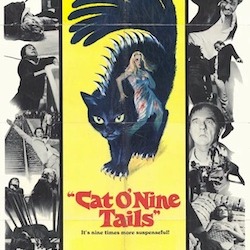
A tradition of the Giallo is that the characters all tend to be dislikable, something Argento at least resisted in Cat O’ Nine Tails and Deep Red. With disposable characters, each of whom might be the killer and each of whose violent demise is served up as a set-piece, this distancing and contempt might just be a byproduct of the form rather than a principle or ethos, but it’s of some interest, perhaps mitigating the misogyny with a wash of misanthropy. A Unified Field Theory of Gialli would find a more deep-seated reason for the obnoxious characters as well as the stylized snuff and the glamorous presentation. What urge is being satisfied, and why here, now, like this?
Class war? Though prostitute-ripping is encouraged in the Giallo, most victims are wealthy, slashed to ribbons amid opulent interiors. Urbane characters who might previously have graced the sleek “white telephone” films of forties Italian cinema were briefly edged out by neo-realism’s concentration on the working class. Now these exquisite mannequins are trundled back onscreen to be ritually slaughtered for our viewing pleasure.
Victims must always be enviable: either beautiful and sexy or rich and swellegant, or all of the above, so the average moviegoer can rejoice in their dismemberment with a clear conscience. Mario Bava bloodily birthed the genre in Blood and Black Lace (1964), brutally offing fashion models in a variety of Sade-approved ways, the killer a literally faceless assassin into whom the (presumed male) audience could pour their own animosities without ever admitting it, with the female killer finally unmasked to provide exculpatory relief.
If narrative formulas absolve the straight male viewer, compositions have a way of ensnaring him. Beyond that omnivorous indulgence of sensation for its own lurid sake one finds in Giallo, there is a more gilded emphasis placed on Beauty (in the Catholic sense), and it is only the women who are mounted upon its pedestal. That these avatars of beauty are to be savored, ravaged, and brutalized — in that order — is what concerns us. But the sex and the suffering that captivates most sadists is never what registers; no, it is the instance of death, the terror that afflicts the dying woman’s face that resonates. Once again, physical interiors become a negative form of emotional interiority, rooms amplified for the sole purpose of grisly annihilations; a kind of heretical, strictly anti-Catholic transcendence through amoral delight in what otherwise falls under trivial headings, either “the visuals” or “color palette” – neither of which touch the essential nerve endings of Giallo.

Swaddled inside an otherwise hyper-masculine castle lies a windowless chamber with feminine, if not psychotic, decor. Before he tortures and stabs her to death, “Lord Alan Cunningham” (fresh from his sojourn in the asylum) brings his first victim to this pageant of off-gassing plastic furniture, the single most obnoxious vision ever imposed on gothic environs. Risibly overblown ’70s chic rules The Night Evelyn Came Out of the Grave with nods to Edgar Allan Poe, as the modish Lord juggles sports cars and medieval persecution. Laughs escape the viewer’s throat in dry heaves when each new MacGuffin devours itself without warning. Take “Aunt Agatha” (easily two decades younger than her middle-aged nephews) suddenly rising from her motorized wheelchair, clobbered from behind seconds later, her body dragged into a cage where foxes promptly munch her entrails. Nothing comes of this. The phony paralysis, the aunt’s role in a half-dozen mysteries, which include a battalion of sexy maids in miniskirts and blonde Harpo Marx wigs – all gulped, swallowed.
About the only thing we know for certain is that “Aunt Agatha” is gorgeous. Though, in the end, she’s another casualty of the same nihilism that crashes Giallo aesthetics headlong into Poe country. That is into “Lord Alan” and his gaudy room crowded with designer goods to be catalogued in a horror vacui of visual intrusiveness – a trashy shrine to his late wife, the titular Evelyn. If lapses of good taste define The Night Evelyn Came Out of the Grave, they also reflect Giallo’s abiding obsession with real estate. After all, this Mod hypnagogia has to fill the eye somewhere. Why not bang in the middle of a castle? Poe’s The Fall of the House of Usher features a wealthy aristocrat burying his twin sister alive, thereby entombing his own femininity.
Evelyn represents both Usher’s primary theme of the divided self and the obdurate refusal to learn from it. “Alan,” who emerges a moral hero in the end (after his shrink aids and abets his murder spree), remains just as ornery, alienated, and vainglorious as Giallo itself. We’re never told precisely what the film’s fetish objects are supposed to mean. And since the camera seizes upon each one with existential grimness, we’re left with a visual style that begs its own questions.
Function follows form into the abyss. One Ophelia after another dies to satisfy our cruel delectation, even as will-o’-the-wisp light, taken from the bogs and neglected cemeteries of Gothic Horror, finds itself transformed into a crimson-dripping stiletto. Evelyn stands in for all Gialli, a genre which redefines film itself on the narrow front of visual impact: stainless steel cutlery and candy-colored light enact a sentient agenda as color becomes an instrument of hyperbolic misogyny that fills the eye and then some.
As with certain other Italian genres, notably the peplum, smart characterization, solid performances and decent dialogue seem not only unnecessary to the Giallo but unwelcome (the spaghetti western, conversely, in which many of the same directors dabbled, seemed to demand a steady stream of good, cold-blooded wise-cracks). Argento, in pursuit of that “non-Cartesian” quality he admired in Poe, took this to extremes, stringing non-sequiturs together to form absurdist cut-ups, torching his stars’ credibility merely by forcing them to utter such nonsense. And this wasn’t enough: from Suspiria (1977) on, the psychological thriller (which the Giallo is a sub-genre of, only the psychology has to be deliberately nonsensical) was increasingly replaced by the supernatural. So that the laws of nature could be suspended along with the laws of coherent motivation.
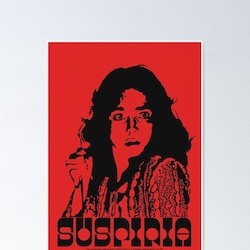
In Suspiria and its 1980 quasi-sequel Inferno, the traditional knifings are interspersed with more uncanny events, as when a stone eagle comes to life and somehow makes a seeing-eye dog kill his owner, and there are also grotesque incidents with no relation to story whatever: a shower of maggots, or an attack by voracious rats in Central Park. The Giallo’s quest for a solution, inspired as it was by the old-school whodunits, is all but abandoned, replaced by the search for the next sensational set-piece.
Argento’s villains are now witches, but, abandoning centuries of tradition, these witches show more interest in stabbing their fellow women with kitchen knives than with worshipping Satan or riding broomsticks. Regardless of who they’re meant to be, Argento’s characters must express his desires, enact the atrocities he dreams of. And inhabit places built for his aesthetic pleasure rather than their own. Following Bava’s cue, he saturates his rooms in light blasted through colored gels, making every scene a stained-glass icon, no naturalistic explanation offered for the lurid tinted hues. Just as no explanation is offered for the presence of a room full of coiled razor-wire in a ballet school, or for the behavior of the young woman who throws herself into its midst without looking.
Dario Argento’s true significance, at least with respect to Giallo, was perceiving in the nick of time the almost incandescent obviousness of its limitations; that Italian commercial cinema’s garish, polychromatic spin on the garden-variety psychological thriller – departing from its forebears mainly in the rampant senselessness of its “psychology” – had Dead End written all over it. It could never last. On the other hand, Giallo does take a fresh turn with Argento’s Inferno, thanks in no small measure to a woman screenwriter who sadly remains uncredited. Daria Nicolodi explains that “having fought so hard to see my humble but excellent work in Suspiria recognized (up until a few days before the première I didn’t know if I would see my name in the film credits), I didn’t want to live through that again, so I said, ‘Do as you please, in any case, the story will talk for me because I wrote it.’”

Daria Nicolodi
Nicolodi’s conception humanizes (it would be tempting to say “feminizes”) Argento’s usual sanguinary exercises du style, while at the same time summoning legitimate psychology. This has nothing to do with strong characterization – indeed, the characters barely speak – and everything to do with the elemental power of water, fire, wind.… Inferno rescues Giallo by plunging it into seemingly endless visual interludes, a cinema that draws its strength from absence.
by The Chiselers
Daniel Riccuito, David Cairns, Tom Sutpen, and Richard Chetwynd
5 notes
·
View notes
Text
Halloween playlist
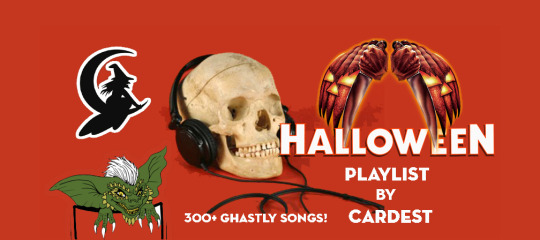
Halloween playlist By Cardest October is my favorite time of the year! Here is 300 songs or so I put together I think will make your Halloween rock! 001 The Misfits - Scream! 002 Alice Cooper - The Nightmare Returns 003 Acid Witch - I'm Back (Sorcery cover) 004 John Carpenter\Alan Howarth - Halloween Theme 005 King Diamond - Halloween 006 Ghost - Mummy Dust 007 Jerry Goldsmith The Omen OST - Ave Satani 008 Fantomas - Der Golem 009 Doyle - Cemeterysexxx 010 Mastodon - Halloween (Instrumental) 011 Cramps - Human Fly 012 Fright Night Soundtrack - Armies Of The Night 013 Shooting Guns - [Wolfcop Soundtrack - Wulver 014 Oingo Boingo - Dead Man's Party 015 Type O Negative - Halloween In Heaven 016 Phantasm OST - Funeral organ-dwarf in hearse 017 Grave Robber - Skeletons 018 John Carpenter - Theme from "The Fog" 019 45 Grave - Night Of The Demons 020 The Birthday Massacre - Horror Show 021 Bernard Herrmann - Psycho (theme) 022 The Misfits - Friday the 13th 023 Blood Ceremony - Coven Tree 024 Goblin - Profondo Rosso 025 October 31 - The House Where Evil Dwells 026 Michael Jackson - Thriller 027 Bobby 'Boris' Pickett & The Crypt Kickers - Monster Mash 028 Ministry - Every Day Is Halloween 029 Sleepy Hollow movie Theme 030 The Damned - Dr Jekyll and Mr Hyde 031 October 31 - The house where evil dwells 032 Rigor Mortis - poltergeist 033 Necrophagia - Reborn through Black Mass 034 Fantomas - Rosemary's Baby 035 Pseudo Echo - His Eyes (from the Friday the 13th V OST) 036 Misfits - Dig Up Her Bones 037 Sigh - Graveward 038 Christian Death - Church of no return 039 The Rocky Horror Picture Show - Over At The Frankenstein Place 040 With The Dead - Nephthys 041 David Bowie- Scary Monsters (And super creeps) 042 Early Man - Creature From The Black Lagoon 043 Hellbound Hellraiser 2 Theme 044 Rob Zombie - Dragula 045 Misfits - Night of the Living dead 046 Ramones - Pet Semetary 047 Roky Erickson - I walked with a zombie 048 Blue Oyster Cult - Don't (fear the reaper) 049 The Munsters TV show theme 050 Slayer - Necrophobic 051 Type O Negative - Wolf Moon (Including Zoanthropic Paranoia) 052 The 69 Eyes - Lost Boys 053 The Vision Bleak - The Night Of The Living Dead 054 The Devil's Blood - I'll Be Your Ghost 055 Ghost B.C. - Ghuleh / Zombie Queen 056 Voltaire - Brains! 057 The Shrine - Tripping Corpse 058 Zig Zags - The Fog 059 Doyle - Land of the Dead 060 Danzig - On A Wicked Night 061 Fantomas - One Step Beyond 062 Siouxsie And The Banshees - Dear Prudence 063 The Misfits - Nightmare on Elm Street 064 Warren Zevon - Werewolves Of London 065 The Cramps - Creature From The Black Leather Lagoon 066 King Diamond - Trick Or Treat 067 Arcturus - To Thou Who Dwellest in the Night 068 Deicide - Dead But Dreaming 069 Zombie Ghost Train - R.I.P 070 American Horror Story - Theme Song 071 Antonius Rex - Necromancer 072 THE WOLFGANGS - Cannibal Family 073 THE TWILIGHT ZONE THEME 074 Queens Of The Stone Age - Burn The Witch 075 The Hellfreaks - Boogieman 076 Ghoultown - Drink With The Living Dead 077 Fantomas - Experiment In Terror 078 Coil - Main Title (Unreleased Hellraiser Theme) 079 Autopsy - Skull Grinder 080 Beastmaker - Eyes Are Watching 081 S.O.D. - Freddy Krueger 082 Christopher Lennertz - And So It Begins Supernatural OST 083 Xandria -Vampire 084 Slayer - Ghosts Of War085 085 With The Dead - Living With The Dead 086 Devil Master - Listen, Sweet Demons... 087 G Tom Mac - Cry LIttle Sister 088 Celtic Frost - The Usurper 089 The Moving Sidewalks - Crimson Witch 090 Electric Wizard - Black Mass 091 Return Of The Living Dead Theme 092 Carcass - The Master Butcher's Apron 093 Cedell Davis - She's Got the Devil in Her 094 Zombi OST - Zombie Vs Shark 095 Rob Zombie - House of 1000 Corpses 096 Calabrese - Vampires Don't Exist 097 Dario Argento's LA TERZA MADRE - Main Theme by Claudio Simonetti 098 The Damned - Dr. Jekyll & Mr. Hyde 099 Danzig - Bodies 100 Slayer - Postmortem 101 Fantomas - The Omen (Ave Satani) 102 Cannibal Corpse - The Cryptic Stench 103 The Vampires of Dartmoore - Hallo, mister Hitchcock 104 45 Grave - Party Time 105 Coffins - Decapitated Crawl 106 The Misfits - Them 107 Talking Heads - Psycho Killer 108 Denial Of God - The Curse Of The Witch 109 Lucio Fulci's Zombie Theme 110 Anthrax - Bordello Of Blood (Tales From The Crypt) 111 Iron Maiden - Phantom Of The Opera 112 The Exorcist Theme 113 Demented Are Go - Hotrod Vampires 114 The Creepshow - Zombies Ate Her Brain 115 Tenebre (Main Title) by Goblin 116 Voltaire - Zombie Prostitute 117 HorrorPops - [Bring It On! #09] Walk Like A Zombie 118 Death - Open Casket 119 Friday The 13th Original Theme Song 120 Wesley Willis - Vampire Bat 121 The Cult - The Witch 122 Dracula (1931) Theme Bela Lugosi 123 Slayer - Live Undead 124 Re-Animator Theme 125 Ray Parker Jnr - Ghostbusters 126 Megadeth - The Conjuring 127 Santana - Black Magic Woman 128 The Who - Boris The Spider 129 Entombed - Evilyn 130 Nick Cave & The Bad Seeds - Red Right Hand 131 Twisted Sister - Burn In Hell 132 The Edgar Winter Group - Frankenstein 133 Electric Wizard - Dunwich 134 Danzig - Skin Carver 135 King Diamond - Them 136 Salems Lot Theme 137 Dio - Dream Evil 138 Tenacious D - Beelzeboss 139 Dokken - dream warrior 140 The Doors - The Ghost Song 141 Saint Vitus - White Magic/Black Magic 142 The Vampires of Dartmoore - Crime and Horror 143 Fantomas - Spider Baby 144 Rockwell - Somebody's Watching Me 145 Samhain - Halloween II 146 Blue Oyster Cult - Godzilla 147 The Five Blobs - The Blob 148 Rob Zombie - Superbeast 149 The Cramps - Big Black Witchcraft Rock 150 Phantasm Theme Song 151 The Addams Family TV theme song 152 Slayer - Black Magic 153 Necrophagia - Rue Morgue Disciple 154 Bastard Priest - Ghouls Of The Endless Night 155 Ennio Morricone - The Thing (theme) 156 The Vision Bleak - The Wood Hag 157 Soulfly - Cannibal Holocaust 158 Creepshow 2 - Original Theme Music 159 Dracula theme - Bram Stoker's Dracula theme 160 Monster Magnet - 19 Witches 161 Blood Ceremony - My Demon Brother 162 Janet Jackson - Black Cat 163 Cramps - I Was A Teenage Werewolf 164 Nosferatu - A Symphony of Horror 165 The Evil Dead - Pencil It In 166 White Zombie - Cosmic Monsters Inc. 167 Fred Schneider - Monster 168 Men At Work - Dr. Heckyll & Mr. Jive 169 Cathedral - Hopkins (The Witchfinder General) 170 Thomas Dolby - She Blinded Me With Science 171 A Nightmare on Elm Street - Theme Song 172 The Misfits - Halloween II 173 The Guess Who - Clap for the Wolfman 174 Inter Arma - Scarecrow 175 Royal Thunder - Sleeping Witch 176 Slayer - Spirit in Black 177 Yoga - Flying Witch 178 Down - Witchtripper 179 Witchcraft - Ghosts House 180 Serge Gainsbourg - Docteur Jekyll et monsieur Hyde 181 Danny Elfman - [Sleepy Hollow OST] Into The Woods (The Witch) 182 Deicide - Dead by Dawn 183 Elm Street - Elm St's Children 184 Acid Witch - Trick or Treat 185 Satyricon - Black Crow On A Tombstone 186 Possessed - The excorcist 187 Electric Wizard - Satanic Rites Of Dracula 188 Concrete Blonde - Bloodletting (The Vampire Song) 189 Predator Soundtrack - Main Title 190 Kryst The Conqueror - Doctor Phibes Rises Again 191 Ministry - Every Day is Halloween (remix) 192 Megadeth - Devils Island 193 The Misfits - From Hell They Came 194 Devil Master - Black Flame Candle 195 Soiuxee and the Banshees - Fear (Of The Unknown) 196 Cradle of Filth - Her Ghost in the Fog 197 Goblin - Witch (Suspiria Soundtrack) 198 Cliff Richard - Devil Woman 199 NIN - Dead Souls (From The Crow Soundtrack) 200 Alice Cooper - Teenage Frankenstein 201 Misfits - Cold in Hell 202 John Carpenter - Halloween 2019 Theme (Main Title) 203 The Damned - Grimly feindish 204 Slayer - At Dawn They Sleep 205 Atrium - Doctor Jekyll 206 Serge Gainsbourg - Docteur Jekyll et monsieur Hyde 207 Darkthrone - Graveyard Slut 208 Faith No More - Zombie Eaters 209 Candlemass - Demons Gate 210 Bauhaus - Bela Lugosi's Dead 211 Rigor Mortis - Vampire 212 Rob Zombie - In The Age Of The Consegrated Vampire We All Get High 213 BLOODY HAMMERS - Witch Of Endor 214 Ghost - Spirit 215 Autopsy - Tourniquets, Hacksaws And Graves 216 Alice Cooper - Keepin' Halloween Alive 217 Old Man's Child - Return Of The Night Creatures 218 Black Sabbath - Black Moon 219 The Misfits - Walk Among Us 220 Early Man - Frankenstein: I'm Dead Alive 221 Ghoul - Dungeon Bastards 222 Slayer - Spill The Blood 223 Carcass - Corporal Jigsore Quandary 224 Over Kill - playing with spiders/ skullcrusher 225 Frankie Stein And His Ghouls - Elbow Twist 226 Mercyful Fate - Black Masses 227 The Elm Street Group - Do The Freddy 228 Instant Funk - Witch Doctor 229 Cathedral - Tombs Of The Blind Dead 230 Celtic Frost - Necromantical Screams 231 Grave Digger - Witch Hunter 232 Basil Kirchin - Dr Phibes' Theme 233 Necrophagia - Coffins 234 The Misfits - Monster Mash 235 The Vision Bleak - Witching Hour 236 The Vision Bleak - A Witch Is Born 237 Megadeth - Last rites/loved to death 238 Overkill - Frankenstein 239 Dave Edmunds - The Creature from the Black Lagoon 240 Death - Zombie Ritual 241 John Fogerty - Eye Of The Zombie 242 Nunslaughter - Ouija 243 Main Title (Stephen King's IT) 244 Goblin - Zombi 245 White Zombie - I, zombie 246 XTC - Ballad Of Peter Pumpkinhead 247 Misfits - Green Hell 248 Autopsy - Embalmed 249 Slayer - Haunting The Chapel 250 The Devin Townsend Band - Vampira 251 The Frantics - Werewolf 252 Black Sabbath OST by Les Baxter - Main theme 253 Slasher Dave - Moldy coffins 254 Morricone Youth's Night of the Living Dead - Driveway to the cemetary 255 Bob McFadden - The Mummy 256 Screaming Jay Hawkins - I put a spell on you 257 Eurythmics - Sweet Dreams 258 Buddy Haydock & The Boppers - The Raven 259 Helloween - Halloween 260 The Ghastly Ones - Draculon (with intro) 261 Echo & the Bunnymen - People are strange 262 Exhumed - Slaughter maniac 263 Nightmare Before Christmas OST - This is Halloween 264 Cerrone - Supernature 265 The Specials - Ghost town 266 The Cramps - Surfin' dead 267 David Bowie's Labyrinth OST - Magic dance 268 Lalo Schifrin Abominable OST - maine title 269 The Castle Kings - You can get him Frankenstein 270 Ozzy Osbourne - Bark at the moon 271 The Grave Mistakes - Dig your own grave 272 Demons 2 OST - Videomix 273 Wolfmen of Mars - Mouth like Piranha 274 Entrails - The cemetary horrors 275 Obituary - Blood soaked 276 Cannibis Corpse - Mummified in bong water 277 Dawn of the Dead OST - theme song 278 Exodus - Piranha 279 Danny Elfmann's Nightbreed OST - end credits 280 Rigor Mortis - Wizard of gore 281 Ancient Order of the Droids - Torus 282 The Damned - Black is the night 283 Angry Birds Seasons Halloween - Haunted Hogs Theme 284 Dunwich Horror OST by Les Baxter - Black mass 285 Chopping Mall OST - movie theme 286 The Simpsons Tree House of Horror - Halloween Special theme 287 The B-52's - Devil in my car 288 Cannibal Corpse - Beyond the cemetary 289 Sturgil Simpson - The Dead Don't Die 290 Chained to the Dead - Beheaded by Berrymen 291 Sisters of Mercy - This corrosion 292 Exhumed - Defenders of the grave 293 The Cure - The forest 294 Book of Love - Witchcraft 295 Alice Cooper - Welcome to my Nightmare 296 TSOL - Wash away 297 Death - Born Dead 298 Scooby Dooby Do TV Show - theme song 299 Dead Vampires - The Day after Halloween 300 Danny Elfmann's Beetlejuice - main title 666 ACID WITCH - I Hate Halloween 999 Misfits - Halloween
14 notes
·
View notes
Text
watchlist for 2020 2020 reading list last updated 8.1.2020
I know there aren’t a lot of films directed by women or non-Western directors on this list, so if any of you have any recommendations I would love to hear them! I’m going to do some of my own research, but if you guys know any lesser known ones I’d love to add them to my list!
Faust (1926) dir. F. W. Murnau Rebecca (1940) dir. Alfred Hitchcock Rope (1948) dir. Alfred Hitchcock Secret beyond the Door (1948) dir. Fritz Lang Noita palaa elämään / The Witch (1952) dir. by Roland af Hällström North by Northwest (1959) dir. Alfred Hitchcock 1960s Et mourir de plaisir (1960) dir. Roger Vadim Persona (1960) dir. Ingmar Bergman The Pit and the Pendulum (1961) dir. Roger Corman Cleo from 5 to 7 (1962) dir. Agnès Varda I tre volti della paura / Black Sabbath (1963) dir. Mario Bava Lilith (1964) dir. Robert Rossen Vampirisme (1967) dir. Bernard Chaouat; Patrice Duvic The Satanist (1968) dir. Zoltan G. Spencer Le viol du vampire (1968) dir. Jean Rollin
1970s Le frisson des vampires (1970) dir. Jean Rollin The Vampire Doll (1970) dir. Michio Yamamoto La rose écorchée / The Blood Rose (1970) dir. Claude Mulot Ovoce stromu rajských jíme / Full of Paradise (1970) dir. Vera Chytilová +Trzecia część nocy / The Third Part of the Night (1971) dir. Andrzej Żuławski Les Lèvres Rouges / The Red Lips (1971) dir. Harry Kümel Una lucertola con la pelle di donna / A Lizard in a Woman’s Skin (1971) dir. Lucio Fulci Viskningar och Rop / Cries and Whispers (1972) dir. Ingmar Bergman Diabeł (1972) dir. Andrzej Żuławski La notte dei diavoli / Night of the Devils (1972) dir. Giorgio Ferroni Ángeles y querubines / Angels and Cherubs (1972) dir. Rafael Corkidi The Blood Spattered Bride (1972) dir. Vicente Aranda La morte negli occhi del gatto / Seven Deaths in a Cat’s Eye (1973) dir. Antonio Margheriti Cannibal Girls (1973) dir. Ivan Reitman +Ganja & Hess (1973) dir. Bill Gun La Rose de Fer / The Iron Rose (1973) dir. Jean Rollin Lady Snowblood (1973) dir. Toshiya Fujita +Messiah of Evil (1973) dir. Gloria Katz & Willard Huyck Female Vampire (1973) dir. Jesús Franco Thriller – en grym film / Thriller: A Cruel Picture (1973) dir. Bo Arne Vibenius Bloody Murder / …la main à couper (1974) dir. Etienne Périer +La Bête / The Beast (1975) dir. Walerian Borowczyk Dzieje grzechu / The Story of Sin (1975) dir. Walerian Borowczyk La Marge / The Stalker (1975) dir. Walerian Borowczyk +Sebastiane (1975) dir. Derek Jarman Profondo rosso / Deep Red (1975) dir. Dario Argento +Salomé (1976) dir. Téo Harnadez +Die Marquise von O… / The Maquis of O… (1976) dir. Éric Rohmer The Witch Who Came from the Sea (1976) dir. Matt Cimber The Uncanny (1977) dir. Denis Héroux Death Bed: The Bed That Eats (1977) dir. George Barry Portret (1977) dir. Stanisław Lenartowicz. Escalofrío / Satan’s Blood (1978) dir. Carlos Puerto +Nosferatu: Phantom der Nacht (1979) dir. Werner Herzog Les Sœurs Brontë / The Brontë Sisters (1979) dir. André Téchiné A Mulher Que Inventou o Amor / The Woman Who Invented Love (1979) dir. Jean Garrett +Fascination (1979) dir. Jean Rollin Les héroïnes du mal / Immoral Women (1979) dir. Walerian Borowczyk
1980s Aus dem Leben der Marionetten / From the Life of the Marionettes (1980) dir. Ingmar Bergman La Dame aux camélias / The Lady of the Camellias (1980) dir. Mauro Bolognini Inferno (1980) dir. Dario Argento La nuit des traquées / The Night of the Hunted (1980) dir. Jean Rollin +Dressed to Kill (1980) dir. Brian de Palma Docteur Jekyll et les femmes (1981) dir. Walerian Borowczyk +Possession (1981) dir. Andrzej Żuławski Blow Out (1981) dir. Brian de Palma La morte vivante / The Living Dead Girl (1982) dir. Jean Rollin Tenebre (1982) dir. Dario Argento Lovely Devil (1982) dir. Nobuhiko Obayashi Angst (1983) dir. Gerald Kargl The Gold of Love (1983) dir. Eckhart Schmidt The Legend of Suram Fortress (1984) Sergei Parajanov Body Double (1984) dir. Brian de Palma +Caravaggio (1986) dir. Derek Jarman +Der Rosenkönig (1986) dir. Werner Schroeter Sous le soleil de Satan / Under the Sun of Satan (1987) dir. Maurice Pialat Vlčí bouda / Wolf’s Hole (1987) dir. Věra Chytilová +Babette’s Feast (1987) dir.Gabriel Axel Nekromantik (1987) dir. Jörg Buttgereit
1990s Mirror Mirror (1990) dir. Marina Sargenti +Malina (1991) dir. Werner Schroeter Raising Cain (1992) dir. Brian de Palma The Piano (1993) dir. Jane Campion Little Death (1995) dir. Francois Ozon A Casa (1997) dir. Šarūnas Bartas
2000s The Cell (2000) dir. Tarsem Singh Trouble Every Day (2001) dir. Claire Denis Stages of Mourning (2004) dir. Sarah Pucill Perfume: The Story Of A Murderer (2006) dir. Tom Tykwer À l'intérieur (2007) dir. Alexandre Bustillo and Julien Maury Barbe Bleue / Bluebeard (2009) dir. Catherine Breillat Viola di Mare (2009) dir. Donatella Maiorca Le masque de la Méduse (2009) dir. Jean Rollin
2010s Phyllis (2010) dir. Zina Saro-Wiwa Crime d’amour / Love Crime (2010) dir. Alain Corneau Passion (2012) dir. Brian de Palma Goodnight Mommy (2014) dir. Veronika Franz & Severin Fiala Cosmos (2015) dir. Andrzej Żuławski The Lure (2015) dir. Agnieszka Smoczynska Evolution (2015) dir. Lucile Hadzihalilovic +Raw (2016) dir. Julia Ducournau +As Boas Maneiras / Good Manners (2017) dir. Marco Dutra & Juliana Rojas +Portrait de la jeune fille en feu (2019) dir. Céline Sciamma +Parasite (2019) dir. Bong Joon Ho Darlin’ (2019) dir. Pollyanna Mcintosh Brian De Palma’s Filmography Jean Rollin’s filmography Alfred Hitchcock’s filmography Dario Argento’s filmography
finished A Girl Walks Home Alone at Night (2014) dir. Ana Lily Amirpour Red Dragon (2002) dir. Brett Ratner Faust (2011) dir. Alexander Sokurov
51 notes
·
View notes